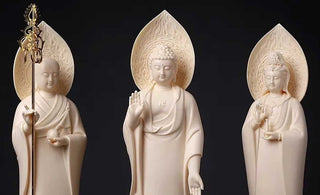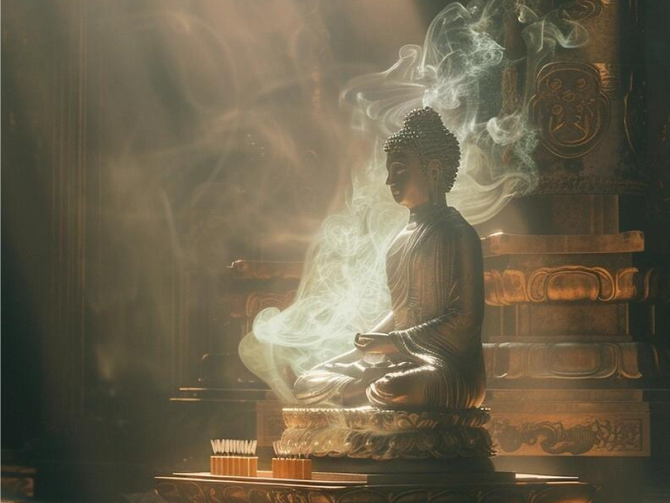
In this article, we embark on a quest to explore the captivating world of the Mahāsthāmaprāpta Statue of Buddha, an iconic masterpiece that embodies strength, wisdom, and spiritual power. Join us as we delve into the rich history, symbolism, and significance of this remarkable statue, aiming to provide you with the most comprehensive and engaging information available.
Unveiling the Mahāsthāmaprāpta Statue of Buddha
The Mahāsthāmaprāpta Statue of Buddha, a masterpiece of oriental art, invites us to delve into its awe-inspiring details and unravel the layers of its profound significance. As we unveil this remarkable statue, we are captivated by its exquisite craftsmanship and the depth of its spiritual symbolism. As we gaze upon the statue, we are drawn to Mahāsthāmaprāpta's dignified expression. The serene countenance reflects a deep sense of inner strength and unwavering determination. It is a face that has transcended the limitations of the physical world, embodying the wisdom and enlightenment attained through rigorous spiritual practice.
Crafted with meticulous precision, the Mahāsthāmaprāpta Statue of Buddha showcases the skill and artistry of oriental artists. Every curve, every contour, and every delicate feature is a testament to their dedication and mastery of their craft. The statue stands as a timeless representation of the Bodhisattva of Great Strength, Mahāsthāmaprāpta, emanating a sense of power, wisdom, and spiritual authority. The artist's attention to detail is evident in every aspect of the statue. The gentle curvature of Mahāsthāmaprāpta's eyes conveys a sense of compassion and insight, while the subtly arched brows suggest a focused and unwavering gaze. The lips, delicately formed, seem poised to impart profound teachings and guidance to those who seek enlightenment. One cannot overlook the symbolic attributes held by Mahāsthāmaprāpta. The treasure vase, often depicted in the statue, represents the abundance of wisdom and virtuous qualities that Mahāsthāmaprāpta possesses and shares with those who seek enlightenment. The vase serves as a reminder to cultivate generosity and to use one's resources for the benefit of all beings.
Symbolism and Meaning
The Mahāsthāmaprāpta Statue of Buddha is steeped in profound symbolism, each element carrying layers of meaning that resonate with seekers of wisdom and enlightenment. Let us delve deeper into the symbolic attributes and their significance, unraveling the messages that this iconic statue imparts. Mahāsthāmaprāpta's dignified and serene expression is a reflection of the inner tranquility and wisdom attained through spiritual practice. It serves as a reminder of the inherent strength that lies within each individual, encouraging us to cultivate inner peace and clarity amidst the chaos of the world. This expression also conveys a sense of compassion and understanding, reminding us to approach others with kindness and empathy.
Another significant symbol associated with Mahāsthāmaprāpta is the lotus flower. The lotus is a powerful symbol in Buddhist teachings, representing purity, enlightenment, and the blossoming of wisdom. Just as the lotus emerges from muddy waters, untouched by the impurities around it, Mahāsthāmaprāpta reminds us that wisdom and enlightenment can arise even in the midst of challenging circumstances. The lotus encourages us to embrace the journey of personal transformation, rising above the struggles and obstacles of life to attain spiritual liberation. In some depictions, Mahāsthāmaprāpta is shown holding a vajra, a symbolic weapon that represents spiritual power and indestructibility. The vajra signifies the unshakable strength and unwavering resolve required to overcome obstacles and challenges on the path to enlightenment. It serves as a reminder that true strength comes from within, enabling us to face adversity with courage and resilience. The specific hand gesture, or mudra, depicted in the Mahāsthāmaprāpta Statue of Buddha also holds symbolic significance. Mahāsthāmaprāpta is often depicted with the Varada Mudra, also known as the gesture of bestowing blessings and granting boons. This mudra signifies the compassionate nature of Mahāsthāmaprāpta, as well as the power to assist and guide sentient beings on their path towards enlightenment. It is a reminder of the boundless compassion and guidance available to us as we navigate our own spiritual journeys.
The Mahāsthāmaprāpta Statue of Buddha, with its rich symbolism, invites us to contemplate the deeper truths of existence and the path to liberation. It serves as a visual representation of the qualities we aspire to cultivate within ourselves – strength, wisdom, compassion, and enlightenment. Each symbol and attribute depicted in the statue carries a profound message, guiding us towards a deeper understanding of ourselves and our connection to the world.
The Quest for Spiritual Strength
Embarking on a quest for spiritual strength is a deeply personal and transformative journey. The Mahāsthāmaprāpta Statue of Buddha serves as a guiding light, inspiring individuals to tap into their inner reservoirs of strength and wisdom. It reminds us that even in the face of adversity, we possess the power to overcome obstacles and progress on the path towards enlightenment. The quest for spiritual strength involves a transformative journey that begins with self-reflection and introspection. It requires individuals to examine their beliefs, values, and priorities, and to confront the aspects of themselves that hinder personal growth and spiritual development. This process of self-discovery and self-transcendence often entails letting go of attachments, healing past wounds, and embracing a mindset of openness and receptivity. For many seekers, the quest for spiritual strength involves establishing a connection with a higher power or a transcendent reality. This connection may be experienced as a sense of divine presence, universal consciousness, or a sacred energy that guides, supports, and sustains the individual on their spiritual journey. This connection provides solace, inspiration, and a profound sense of belonging to something greater than oneself.
In conclusion, the Mahāsthāmaprāpta Statue of Buddha stands as a testament to the profound strength and wisdom embodied within classical oriental art. Its dignified expression, symbolic attributes, and rich symbolism offer a doorway to spiritual growth and enlightenment. As you embark on your own quest for spiritual growth and enlightenment, let the Mahāsthāmaprāpta Statue of Buddha and Oriental Aesthetics be your guiding companions. Together, we can explore the rich symbolism, profound meaning, and timeless beauty of classical oriental art, unlocking the treasures of wisdom and inspiration that await us on this remarkable journey.
























